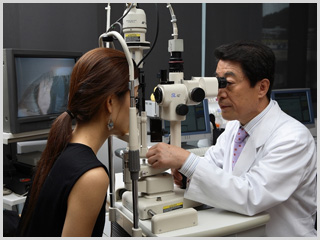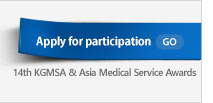
St. Mary’s Eye Hospital is the second or the third biggest hospital in Korea. It is established in 1988 located at Haeundae, Busan. To improve the surroundings for medical treatment, we newly built a medical center which is 3683 ㎡ in size with 2 basements and 9 floors and made a medical system which connects internal medicine, dental center, dermatology center and otorhinolaryngology so that they can collaborate with each other and give general medical treatment for clients. In addition, we remodeled the main building, so patients can get treatment in comfortable, convenient environment all the time.
As of 2008, 10 medical specialists and 4 interns who specialized in different fields are working for our hospital. Our hospital is fitting to be called ‘a hospital specializing in Ophthalmology’ because we can treat and operate for all the eye problems such as cataracts, glaucoma, retina problems, eye cosmetic surgery, strabismus, etc. We performed 2889 surgical operations for cataracts, and this figure is the second biggest in Korea, according to National Heath Insurance Cooperation.
It is noteworthy that the number of the operation in our hospital exceeded that of the foremost university hospitals in Seoul. The hospital director Lee, Gyeong-heon had performed surgery for cataracts by using Phacoemulsification before 1998 when our hospital was opened. He is such an outstanding physician for cataract treatment, and he himself held a medical conference of the Academy of Cataract and Refractive Surgery three times in 1990, 1992, and 1995 to make Phacoemulsification common. In addition, he is regarded as a pioneer in the field of operations to correct nearsightedness because he performed PRK in 1991, LASIC in1995, and ICL(Implantable Contact Lens) surgery in 1997. Furthermore, St. Mary’s Eye Hospital does justice to its name, since every year more than 5000 operations for cataracts, glaucoma, eye cosmetic surgery, and strabismus(including an average of 650 operations for retina problems per year) are performed.
St. Mary’s Eye Hospital has a global network with foreign hospitals, and it makes our hospital much more competitive. Connected with Clyton Eye Center in the U.S., Yoshida Eye Hospital in Japan, and Qingdao University Hospital in China, we share up-to-date medical technology and information so that we may interchange more advanced medical techniques with each other. For example, hospital director Lee, Gyeong-heon played a part in delivering LASIK skills and educating doctors.
St. Mary’s Eye Hospital has every equipment that a Ophthalmology hospital is supposed to have. We introduced a microkeratome for the first time in Busan, and this machine is for IntraLASIK which is considered as the safest operation to correct nearsightedness. There are two ultrasonic surgical instruments called ‘Infiniti’ exclusively at our hospital, and patients feel great contentment after surgery with these machines because they shorten the time of cataract surgery and cause minimum damage to corneal endothelial cells.
To keep with the new ‘Anti-aging’ trend, we are establishing ourselves in correcting farsightedness. We performed various surgery to correct farsightedness, including LTK(Laser Thermal Keratoplasty) from 2002, and CK (Conductive Keratoplasty) and Accommodative IOL(intraocular lens) in 2007. These days we are using primarily CustomVue Laser Vision Correction with the experiences above. CustomVue procedure is accumulation of state-of-the-art technology such as iris recognition, and correction of Cycloduction and Pupil Centroid Shift which makes it possible to analize even minute deflection of the eyeball and to shoot lasers accurately on the cornea. This procedure helps patients to see clearly without magnifying glasses with corrected vision of more than 1.0, and it was acknowledged by FDA in 2007. The procedure takes shorter time, and patients feel little pain and recover quickly enough to do daily activities on the very next day after surgery.
We do not neglect in sharing with others. We provided free treatment and surgery for those who live in the leprosy settlement at Yongho-dong, Busan from 1988 when the hospital was opened, and later for leprous patients in Gijang-gun and Milyang-si. We continue helping Health Centers with medical treatment for soldier regular, and doing checkup for students of Busan School for the Blind, and giving treatment and education at Busan-si Sports Center, the Elderly College, the Elderly Community Center, and churches. In addition, we performed a free eyesight recovery operation 17 times in Vietnam and 3 times in China where medical science relatively falls behind. As a result, every time between 30 and 40 patients had the opportunity to recover their sight.
|


